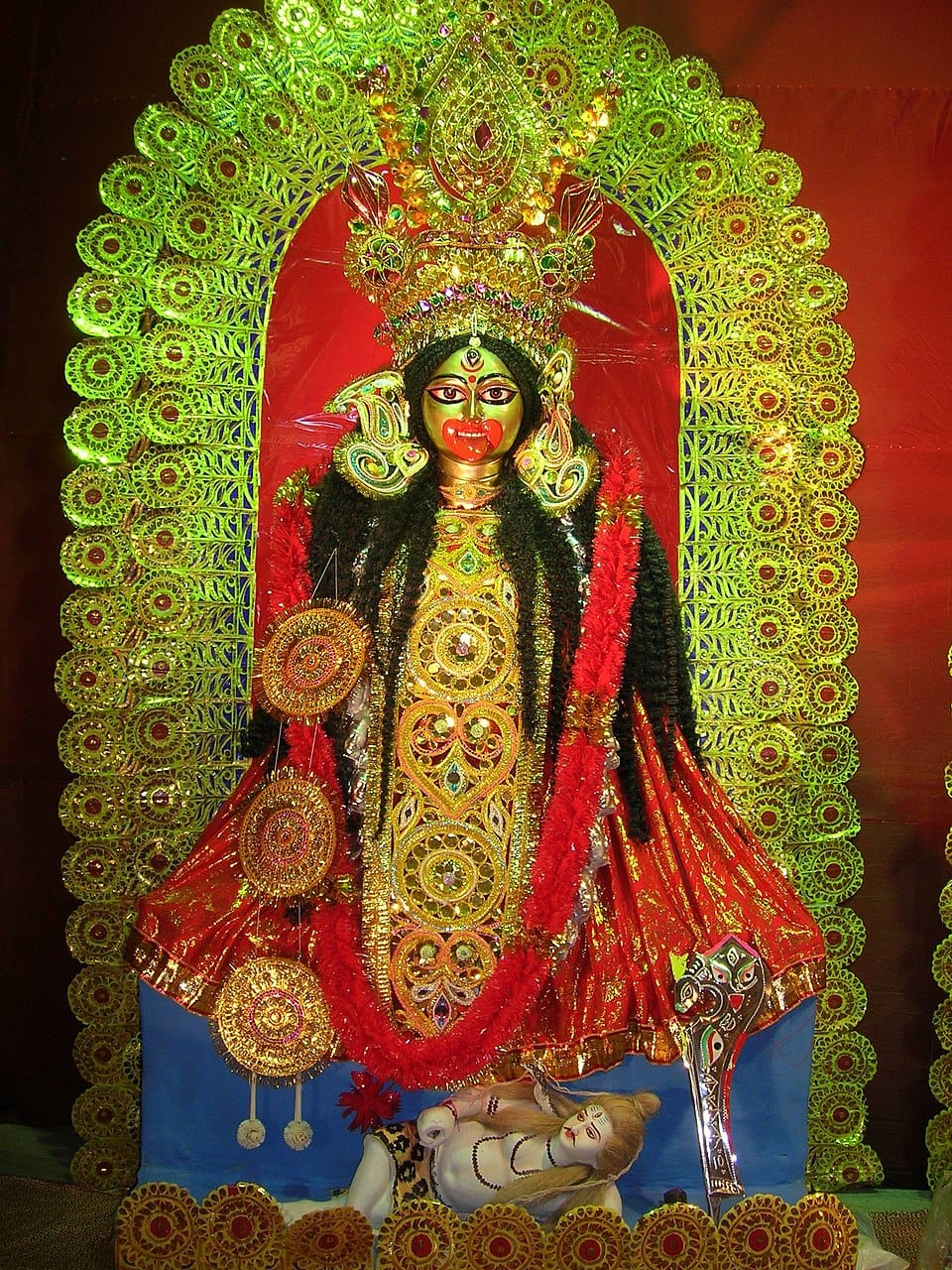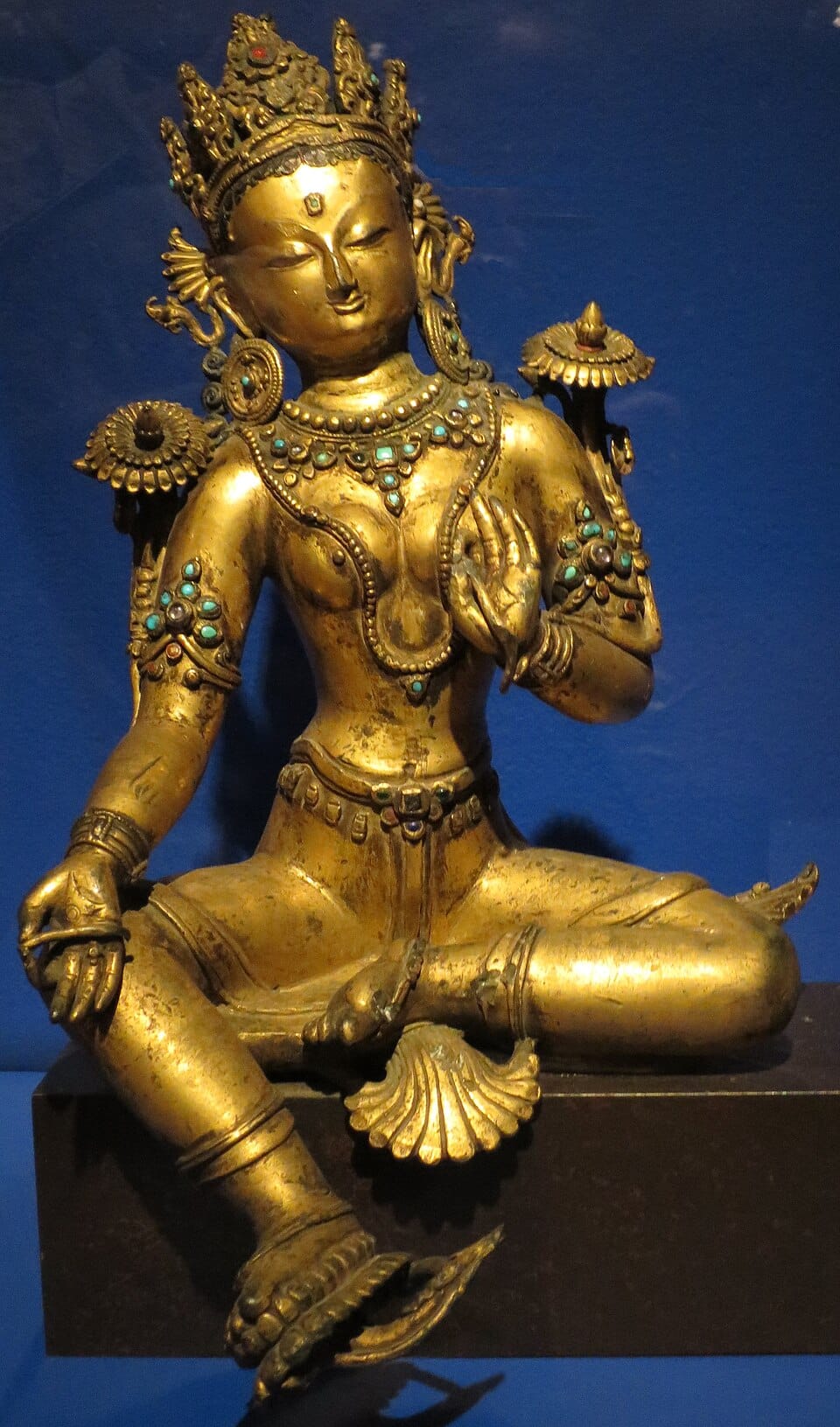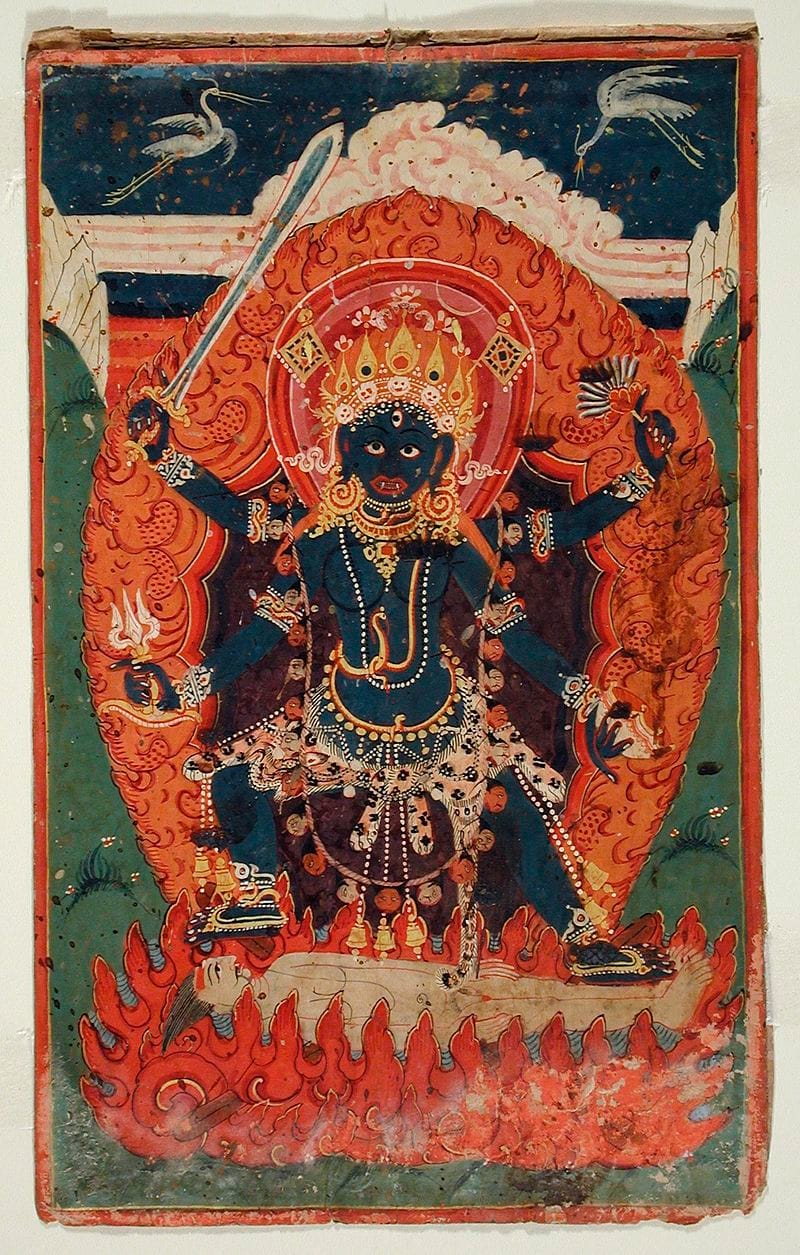In this article, you will read about:
- Significance and Symbolism
- Tarapith Temple
- The Tibetan Ma Tara
- The 21 Taras
- Worshipping Her through Tantra Sadhana
In the stillness of despair, when no answers suffice and no effort seems enough, the Divine does not appear with explanations. Instead, She appears to carry you across - intense in form, tender in essence.
Ma Tara.
She does not soothe your ego; she liberates your soul, just as revealed in the path of Tantra Sadhana.
Significance and Symbolism
Ma Tara is no ordinary goddess. She is the second among the Das Mahavidyas, the ten great Tantric goddesses who represent the highest wisdom.
The early Tantric scriptures—such as the Rudra Yamala Tantra, Brihad Nila Tantra, and Tara Tantra—speak of her not as myth, but as a living presence, a potent energy known as Shakti that reveals itself when the seeker is ready to transcend.
One of Her most ancient stories reveals Her boundless compassion. When Lord Shiva consumed the deadly Halahala poison during the churning of the cosmic ocean and fell unconscious, it was Ma Tara who nursed Him back to life.
She held the destroyer of worlds like a child in Her lap and saved Him by tenderly suckling Him. In that moment, She became both the fierce protector and the nurturing mother—the essence of Tantra itself.
Her name, ‘Tara’, means ‘the one who ferries across’. She helps us cross fear, ignorance, death, and all that binds the soul to suffering.
Her imagery may appear startling - bloodied tongue protruding, holding weapons in Her hands, ferocious expression, a snake coiled around Her neck and hair.
But every symbol is profound: the blood is our resistance to truth, the sword is her piercing clarity, the scissors cut our knots of ignorance and the lotus symbolises how we can rise above worldly mire and bloom.
The snake is Her consort, Akshobhya, another form of Lord Shiva.
She does not destroy us; She dissolves what we are not.
Tarapith: Where the Mother Waits Without Judgment
If Ma calls you, begin. Don't wait for perfection. Don't wait for tomorrow.

There are places that become sacred through time. And then, there are those that were always so - long before we began measuring time.
According to the Puranic texts, when Devi Sati immolated herself in King Daksha’s Yajna, Lord Shiva lifted Her body and walked endlessly, lost in sorrow.
To end His suffering and restore order, Lord Vishnu released His Sudarshan Chakra. Devi Sati’s body was severed into fifty-one parts, and wherever a part fell, it gave rise to a Shakti Peeth.
Tarapith, in Bengal, is one such place.
The Brihat Tantrasara says -
Netram yasya patitam vai, sa sthānam Tārā Peethakam |
Where the eye fell, that place became known as Tarapith.
Tarapith is both a Shakti Peeth—where Devi Sati’s eyeball is believed to have fallen—and a centre of Tantric worship, attracting seekers and saints across India.
Here, Ma’s eyes, smeared in Sindur, do not promise miracles—they offer something greater: Presence.
She does not ask for perfection; she asks for truth.
If you come with a heart laid bare, the Mother won’t just give you Her Darshan—She’ll sit with your brokenness and make it whole.
At Tarapith, beneath a banyan’s shadow, a monk sat in silence for 12 years—unmoving, unseen.
One day, a curious child placed an old skull in his lap.
The monk slowly opened his eyes. Amazed, he whispered, “Ma, You always find a way to show Yourself.”
And then, the skull blinked. Yes, it blinked.
Even now, the locals say—If your devotion is deep, even the dead will open their eyes.
Because in Tarapith, Her gaze hides in the most unexpected places.
But Ma doesn’t exist here alone. She exists across different cultures and traditions.
The Tibetan Ma Tara
Ma Tara is one of Buddhism’s most prominent deities.
Her presence in Buddhism dates back to the 6th–7th century CE. Her earliest mention is in the Tantric, Sadhanamala.
In Mahayana Buddhism, She was recognised as a female Bodhisattva (one who has attained enlightenment in human form) and later, as an enlightened Buddha. She is the embodiment of Avalokiteshvara, the Bodhisattva of Compassion.

According to Tibetan lore, Avalokiteshvara once looked upon the suffering world and wept.
From his tear, a lotus bloomed—and from that lotus arose Ma Tara. She vowed, “As long as there is suffering, I shall remain.”
Another canonical story recounts the tale of a devout princess, Yeshe Dawa, who vowed to remain in her female form until all beings were liberated, declaring that enlightenment transcends gender.
In a time beyond memory, a princess named Yeshe Dawa lived in quiet devotion. She served countless Buddhas with unwavering love.
When asked to seek rebirth as a man to attain enlightenment, she smiled and said, “Truth knows no gender.”
Through deep meditation, she awakened. She became Tara, the compassionate mother who saved all beings from suffering.
In the stillness of sincere effort, She rose - not to be worshipped, but to walk with us, hand in hand, across suffering.
Ma Tara’s practice is rooted in scriptures like the Tara Tantra and Praise To the 21 Taras, where She is invoked for fearlessness, protection, and liberation.
Her role as “She Who Saves” is central to Vajrayana Buddhism and has been one of the most widely practised paths across the Himalayan traditions.
While Ma Tara emerged in the heart of Hindu Tantra, her presence spread across Tibet and blossomed anew with Vajrayana Buddhism.
In this tradition, She manifests in 21 forms, each with its own quality.
The 21 Taras
1. Tara Nyurma Pamo
The Goddess of Swiftness
2. Tara Yangchen Drolma
The Goddess of Wisdom
3. Tara Sonam Tobche
The Goddess of Merit
4. Tara Nyingjé Chenmo
The Goddess of Compassion
5. Tara Lhamo Rabtu
The Goddess of Protection
6. Tara Jigpa Selma
The Goddess of Fearlessness
7. Tara Zhiwa Chö
The Goddess of Peace
8. Tara Tronyer Chen
The Goddess of Wrath
9. Tara Jigten Sumlé
The Goddess of Stability
10. Tara Nammé Karmo
The Goddess of Purity
11. Tara Drölma Yéshe
The Goddess of Insight
12. Tara Namkha Tröma
The Goddess of Liberation
13. Tara Rigné Ma
The Goddess of Healing
14. Tara Barwé Ma
The Goddess of Clarity
15. Tara Me Chenma
The Goddess of Radiance
16. Tara Döndrub Ma
The Goddess of Accomplishment
17. Tara Tsugtor Nampar Gyalma
The Goddess of Victory
18. Tara Mönlam Drölma
The Goddess of Wishes
19. Tara Wangdu Ma
The Goddess of Power
20. Tara Rigdzin Ma
The Goddess of Realisation
21. Tara Samaya Tara
The Goddess of Devotion
Green Tara — The Source of All Taras, or Nyurma Pamo, means ‘She who is Swift’.
She responds faster than thought itself, offering protection from fear and danger.
White Tara bestows longevity and healing.
Others dissolve karmic obstacles, grant wisdom, or guide through inner darkness. Yet, all forms are one compassionate essence, echoing the Hindu understanding of Ma Tara as the fearless Mother who comes when called.
Tibetan Tara Sadhanas are deeply meditative, weaving together visualisation, contemplation, and focused awareness. At their core lies a sacred vibration—one that stills the mind, opens the heart, and invites the presence of the Divine Mother.
Worshipping Ma
Just as Bhagavan Shiva awakens renunciation (Tyag) in the heart, and Vedmata Gayatri blossoms dispassion (Vairagya), Ma Tara, the Bhaya-Nashini, severs the deepest bondage of all, fear, and grants Mukti.
Ma Tara’s worship was once hidden in cremation grounds, mountain caves, and forest hermitages—far from the eyes of the unready.
They helped the seeker transcend worldly fears and break free of societal conditioning.
Through discipline and purification, they invoked Her and realised that the very fear that once held them back was now the fire that awakened them.
They yearned for Her, longed to be one with the boundless Divine Mother.

Are you drawn to Her path in the same way? But don’t have the time, guidance, or access to sit in a cremation ground?
If the longing is there, but life feels limiting, here’s a simple way to begin your journey towards Ma.
Because in Tantra, it is not the place that awakens the Divine.
It is your Shraddha—your inner sincerity. When that is present, even a quiet corner of your home becomes a sacred ground.
Ma Tara on Tantra Sadhana App
Through Tantra Sadhana App, you can now perform Ma Tara’s Shmashan Sadhana from your own home.
Focused on awakening the Das Mahavidyas in your life, the app allows you to awaken each Mahavidya in sequence, beginning with Ma Kali and ending with Ma Kamalatmika.
Ma Tara’s practice starts simply, with mantra japa, and gradually deepens through guided fire offerings.
Over time, it draws you into a symbolic Shmashana —a space within, where the noise quiets down and devotion begins to speak.
This journey is not meant to be rushed. Each step unfolds when you’re ready. The deeper layers stay hidden until your sincerity calls them forth.
This is not a shortcut. It is a sacred bridge between the ancient discipline of Tantra and the steady hand of modern guidance.
It allows you to walk slowly, steadily, and truthfully toward Ma’s living presence.
All the practices in the app have been personally revealed and guided by Om Swami —a living Himalayan Siddha, and a realised master of the Das Mahavidya tradition.
Awakening Ma
Ma Tara transcends religious boundaries, scriptural interpretations, and even language. She cannot be confined to Sanatana Dharma or Buddhism alone.
She is the eternal mother, the inner guide, the power that rises when everything else falls apart.
To call upon Her is not merely to invoke a goddess—it is to touch your own reservoir of courage, clarity, and compassion.
It is to walk through fire and discover you are not burnt.
For sincere seekers, the ancient path still lives. One needs no monastery, no mountain. One only needs the willingness to sit, to feel, to trust.
She is not a deity you worship from a distance. She is a truth you discover within—when all roles are shed, and silence remains.
To walk with Her is to walk in light, even when the path is dark.
She leads. We follow.


